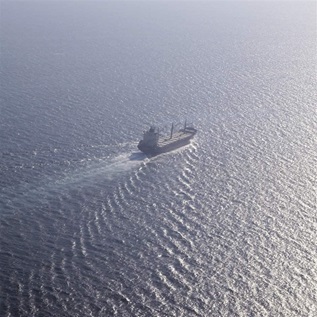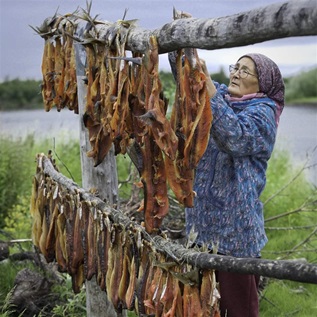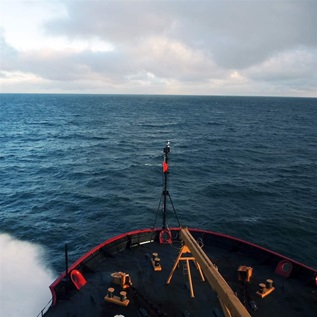Ocean Oil Spills
Impact of oil spills in the U.S. Arctic Ocean from oil and gas development
One of the most significant threats to life in the Arctic from industrial activities is the risk of an oil spill. Alaska’s Arctic Ocean and Bering Sea experience some of the most extreme weather conditions on earth, from high winds and seas to long periods of darkness amidst subzero temperatures. Harsh weather alone can significantly delay clean-up efforts. In addition, adequate technology to clean up oil spills in broken ice has not been proven to work in ice conditions typical of the U.S. Arctic Ocean.
The federal Bureau of Ocean Energy Management, Regulation and Enforcement's Environmental Impact Statement for its 2007-2012 off-shore oil and gas leasing plan predicts at least one large spill in Bristol Bay and two large spills in the U.S. Arctic Ocean as a result of oil and gas activities. In the Chukchi Sea alone, the federal government estimates a 40 percent chance of one or more large spills of more than 1,000 barrels. This poses serious environmental concerns, especially in light of difficulties that the industry has confronted in cleaning up past oil spills.
 © Ken Graham/Accent Alaska.com
© Ken Graham/Accent Alaska.comOil Rig Blowout in Cook Inlet, Alaska
Alaska’s Arctic Ocean is unprepared for a blowout like the Gulf of Mexico BP Deepwater Horizon Exploration Well Incident
- Chukchi Sea exploration sites are located up to 140 miles from shore.
- The possibility of a catastrophic blowout (like the recent BP Deepwater Horizon spill) occurring during exploration in the Beaufort or the Chukchi Sea has been illogically dismissed.
- No technology has been proven to clean up oil in real-world, Arctic Ocean conditions.
- This YouTube video shows a Beaufort Sea ice trial where one, relatively small chunk of ice disables some ocean containment boom.
- Oil spill response assets in the Arctic Ocean are insufficient:
- Remote location;
- Too few and undertrained spill responders;
- Inadequate shoreside infrastructure to handle spill response equipment;
- Outdated and vague maps that fail to identify high priority ecological areas for protection.
To learn more about these challenges and The Pew Charitable Trusts' recommendations to minimize oil spill risks and protect life in the Arctic, read our technical report, “Oil Spill Prevention and Response in the U.S. Arctic Ocean: Unexamined Risks, Unacceptable Consequences.”
Additional Examples of Major Spills, Response Challenges
In 2004, severe weather in the Arctic caused major delays in responding to oil spilled when the Malaysian cargo ship Selendang Ayu ran aground off Unalaska Island in Alaska’s Aleutian Islands The ship broke in half and released a total estimate of 335,732 gallons of f oil into the environment. Six crew members died during the rescue efforts and clean-up operations took months because of treacherous weather.
In the Aleutian Islands the majority of spills have been small discharges from fishing vessels. Twenty vessels in the last two decades contributed to a total of approximately 1,000 gallons of spilled oil. However, during this same time period, just two cargo ships – the Selendang Ayu and another one – were responsible for spilling a total of 376,000 gallons of oil. In all of these cases, most of this spilled oil was not recovered from the marine environment.
 © J.Engles, ADEC
© J.Engles, ADECTugboat Leaks Oil After Running Aground in the Prince William Sound.
In August 2009, an oil rig blowout in an ecologically rich area of the Timor Sea off Australia’s north coast spewed oil for 10 weeks until it was finally capped. The two-year-old rig was constructed to a very high standard. Estimates of the size of the spill ranged from 400 to 3,000 barrels per day. Equipment to plug the leak had to be shipped from Singapore. Four unsuccessful attempts were made to plug the hole located 1.6 miles below the sea bed. Finally, the rig burst into flames just before it was capped. The oil spill spread over thousands of square miles and will have a long-term impact on this area rich with cetaceans, sea birds, and fish.
The industry faced huge challenges in responding to this blowout in the relatively warm, calm waters of the Timor Sea. The response to a similar accident in the remote, stormy waters of the U.S. Arctic Ocean would be far more complicated and the impacts could be far worse.
ENDNOTES:
AMAP. 2008. Arctic Monitoring Assessment Programme.
Coastal Response Research Center. 2009. Opening the Arctic seas: Envisioning disasters and framing solutions. University of New Hampshire, Durham, NH.
FEIS for the 2007-2012 five-year program. http://www.mms.gov/5-year/2007-2012FEIS/Tables4-1thru4-17.pdf.
Torrice, M. 2009.Science lags on saving the Arctic from oil spills. Science 325:1335.











